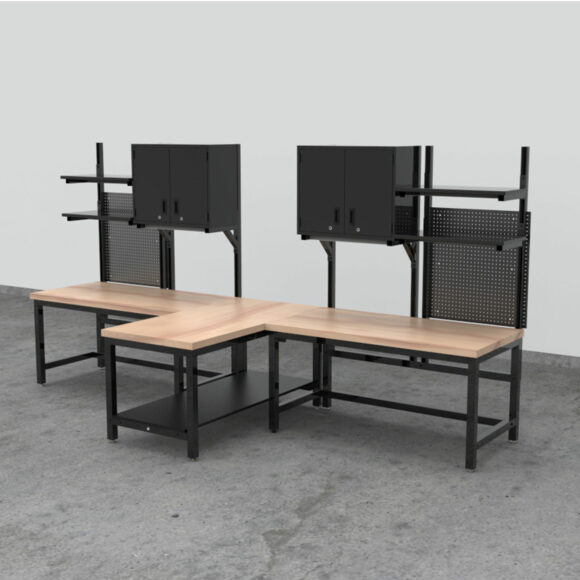The Brave New World of Next Generation 2nm Microchips

Formaspace builds each piece of furniture to order at our factory headquarters in Austin, Texas, allowing you to customize your furniture order to meet your exact needs.
Learn more about delivering the next generation of AI chips and the political risks of concentrating high-tech production in Taiwan.
Artificial Intelligence (AI) has supercharged the chip foundry business, as AI software companies invest hundreds of millions of dollars in purchasing customized AI chips.
One of the next major initiatives of the chip manufacturing companies is to shrink the size of the circuitry inside AI chips even further so they can be used in low-power mobile devices, such as future Apple iPhone models equipped with the recently announced Apple Intelligence features.
When it comes to packing powerful AI computing in mobile devices that have limited battery resources, shrinking the size of the circuits is the name of the game. Smaller circuits, typically referred to by their gate or node size, can be packed in more tightly and use less power.
How Small Can You Go?
The undisputed king of high-power computing (HPC) wafer chip production is the Taiwan Semiconductor Manufacturing Company (commonly known as TSMC.) The company is the breakaway market leader – with a market share for HPC chips estimated at 90% – and its recent lucrative contracts to produce powerful AI chips for Nvidia and Apple have pushed it further in the lead.
In 2022, TSMC and its rival Samsung began small-scale production of their smallest chips to date, the next generation 3nm chips. Production ramped up throughout 2023, and industry analysts believe that Apple bought all of TSMC’s 2023 3nm chip production for their latest products, including the iPhone 15 Pro and the M3-powered MacBook Air and iMac introduced last year.
(Notably, Intel, once the world’s chip manufacturing leader, was not able to meet its previously announced plans to produce 3nm chips and has delayed their introduction until 2025. Concerns about Intel’s manufacturing capability were also called into question due to reported instability in their recent 13th and 14th generation Intel Core CPU chips, code-named Raptor Lake.)
The industry focus is now shifting to the production of 2nm chips.
Korean and Taiwanese media reports indicate that TSMC has commenced preproduction test runs for the production of 2nm chips at its Taiwan chip fabrication (FAB) plants, with mass production still on schedule for 2025.
Does the Introduction of 2nm Chips Mean the End of Moore’s Law is Near?
In 1965, Intel’s co-founder Gordon Moore postulated that the number of transistors on a computer chip would double every 10 years – without incurring a major price increase – a prediction that became known as Moore’s Law.
While Moore’s Law has been incredibly accurate at predicting the massive increase in microchip computing power, it hasn’t stopped critics from fretting about the “inevitable” end of Moore’s Law.
A major concern held by critics is that as more and more transistor gates get packed into a smaller and smaller area, you’ll eventually shrink the circuits down to the size of individual atoms, causing the electric circuits to stop functioning reliably.
Even Gordon Moore himself expressed concern about the end of his law in this 2015 interview, where he postulated that making chip circuitry smaller and smaller would simply cost too much to be economically viable. But he also commended the industry’s creativity in solving problems and predicted that new materials could “extend beyond what we can do with silicon.”
This last statement was very prescient on Moore’s part.
As chip gates have become smaller, they are getting uncomfortably close to the size of silicon atoms in the supporting substrate.
This means a nominal 5nm chip design is theoretically relying on circuit designs that rely on etched metal “wires” that are measured center to center and only 30nm apart. That’s uncomfortably close to the size of the atoms in the silicon substrate, which are 0.2nm in size.
At the time, some critics predicted that 5nm chips could NOT be produced in quantity – but, spoiler alert, they were.
One high-profile example is Nvidia’s most powerful Hopper and Blackwell AI chips that are made using TSMC’s 5nm manufacturing processes.
Will TSMC Prove Critics Wrong and Produce 2nm Chips in Quantity?
But what about 2nm gate sizes?
If we follow the same logic, the nominal width of a 2nm circuit should be equivalent to only 10 silicon atoms.
But first, a quick interruption. As chips have become smaller, the sizing terms used by chip manufacturers (such as “3nm” and “2nm”) have become more like names representing new generations of chip designs (much like we have the marketing names 2G, 3G, 4G, and 5G for successive generation of mobile phones.)
In reality, the gate size of a 2nm chip is about 45nm, and the center-on-center distance between the “wires” is 20nm.
Even with this caveat, that is still a very close shave.
Read more...
Julia Solodovnikova
Formaspace
+1 800-251-1505
email us here
Visit us on social media:
Facebook
X
LinkedIn
Legal Disclaimer:
EIN Presswire provides this news content "as is" without warranty of any kind. We do not accept any responsibility or liability for the accuracy, content, images, videos, licenses, completeness, legality, or reliability of the information contained in this article. If you have any complaints or copyright issues related to this article, kindly contact the author above.


